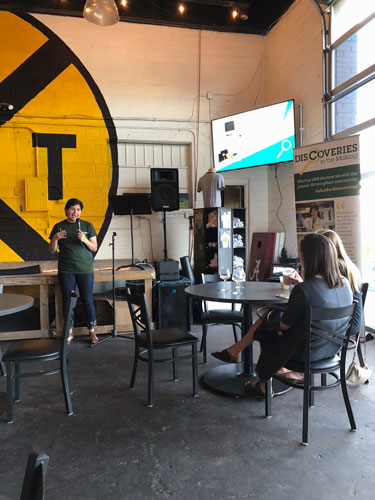Few of us realize the amount of electronic waste (E-waste) the world population is generating. New laptops, computers, smart phones and iPhones are replaced so fast by users looking for more capacity, speed, better resolution. In today’s world, most of our technological devices are replaced as the fast-changing technology has a better version. Ever wondered what happened to all those devices after they are thrown out?
 People at UAB are hard at work looking for an answer to use them effectively. Maria Espinosa a PhD student at the Department of Chemistry, shares at least one of the possible solutions to the problem of electronic waste.
People at UAB are hard at work looking for an answer to use them effectively. Maria Espinosa a PhD student at the Department of Chemistry, shares at least one of the possible solutions to the problem of electronic waste.
For years, developed countries have been sending electronic waste to countries like China, India and a few African countries for disposal. Disposing of electronic waste is a very labor-intensive process, one which is more economically sound in these developing countries. However, China suddenly banned E-waste this year. India and the other African countries do not possess the resources needed to recycle all of the E-waste refused by China.
America alone produces enough E-waste to fill 1,000 football stadiums a year. Plus, to make matters worse, E-waste is a very challenging type of waste to be treated because it is a mixture of a variety of plastic processed with high-grade flame retardants along with metals. Combustion of E-waste will generate toxic fumes that are perilous for humans and the environment. Also, with the growing technology use, there is a growing need for energy. How can we tackle disposing E-waste and generating more energy? Espinosa has come across with a technique that, if improved, holds the potential to produce fuel sources from E-waste using microwaves.
The analogy of a cooked chicken is what she uses to explain this technology.
“When we cook a chicken in the oven it is all brown and crispy on the outside and soft and tender on the inside (just as we like it), but if we cook the chicken in a microwave oven it may not be brown and crispy outside, but it is surely well cooked on the inside,” Espinosa said.
Similarly, using Microwave-assisted Pyrolysis, a special process that uses microwave inside a chamber, we can heat up the E-waste from the inside without burning it. Heating E-waste to temperatures high enough where it could produce three different kinds of fuels – solids (burn to release energy – long carbon chains), liquids (like petroleum – moderate carbon chains) and gases (like methane – small carbon chains). These different fuels can be collected into different condensation chambers and used for different purposes.
This may sound like the perfect process to convert waste into energy, but it is yet to be perfected. One of the roadblocks that have been solved is that microwaves heat up the water molecules in our food, but there is no water to heat in our electronic devices. So, researchers have found that by using some amount of either carbon or iron this problem can be overcome. There’s also the question of coming up with an economical way to escalate microwave reactors to produce more fuels.
Until these questions are answered and a suitable solution is determined, there are several avenues for electronic disposal. A new UAB Recycling initiative, supported by UAB Sustainability, accepts electronics from the community for recycling. These items are then sent to Protec Recycling, which is a commercial entity for recycling E-waste in an environmentally friendly manner.